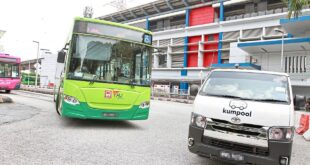Green sea turtle making its way to sea at Pantai Kerachut, Penang. — Filepic
Reptiles help keep Penang seas safer from venomous stings
JELLYFISH bobbing around Penang Island must seem like a delectable treat for the green sea turtle or penyu agar.
There are many videos of different species of sea turtles devouring slow-moving jellyfish.
And that is why green sea turtles are so important to Penang; our nutrient-rich waters encourage growth of jellyfish populations.
When sea currents are favourable to jellyfish, tens of thousands can be seen in the waters around Penang, endangering beach-goers and even making life difficult for other inhabitants of the sea.
Migratory green sea turtles are vital to controlling Penang’s jellyfish population.
Some jellyfish stings can be agonising.The venom comes from specialised cells called nematocysts inside their tentacles. Each tentacle can contain thousands of nematocysts.
Penang has had many cases of tourists and locals being stung by jellyfish while wading along shallow waters.
In March last year, a family picnic in Batu Ferringhi beach became an ordeal when two brothers, aged 13 and 16, were stung by jellyfish while just sitting in knee-deep water.
The teenagers spent a few days in hospital after experiencing breathing difficulties and chest pains.
Sea turtles are protected from the jellyfish sting thanks to their hard shell.
They also have a special, thick layer from throat to stomach called papillae that shields them from venom when eating jellyfish.
The turtle’s only weak spot might be its eyes, but those too are protected by twin eyelids – a tough external one and a transparent inner layer – a trait shared by many other reptiles.
Last year, Penang Fisheries Department recorded 25 female turtle landings.
In 2019, fishermen found a huge female loggerhead turtle weighing 60kg entangled in a ghost net, which is an abandoned fishing net floating around at sea.
It was found near Pulau Kendi, a rocky isle about 4km south of Penang island.
After fishermen cut it free of the ghost net, they saw that it was too weak to swim and simply floated motionless.
So they brought it on board their boat and took it to the Fisheries Department.
What was amazing is that loggerhead turtles have never been recorded landing in Penang.
The species is endangered and usually found in the Atlantic, Pacific and Indian oceans and Mediterranean Sea, but not in Malaysia.
This particular turtle was likely drawn to Pulau Kendi due to the abundance of food there.
Both green and hawkbill turtles land to lay their eggs on Penang beaches.
Simply put, the more turtles we have, the safer Penang seas are from jellyfish.
But there is a problem: a plastic bag floating at sea can really look like a delicious jellyfish to a turtle.
Dead turtles are found around the world with plastic bags jammed inside their bellies. Sometimes, plastic straws too.
The next piece of plastic you throw away might be a turtle’s cause of death.
Most of us already know about the environmental dangers of plastic and the need to cut down on its usage every way we can.
The simple actions we can do include carrying reusable bags when shopping, bringing your own containers when buying food, and cleaning and separating plastic waste from household rubbish and sending it for recycling.
Universiti Sains Malaysia’s Centre for Marine and Coastal Studies director Prof Datuk Dr Aileen Tan confirmed jellyfish infestations control would be better with a healthy population of turtles in our waters.
 BeritaKini.biz Berita Viral Terkini di Malaysia
BeritaKini.biz Berita Viral Terkini di Malaysia





